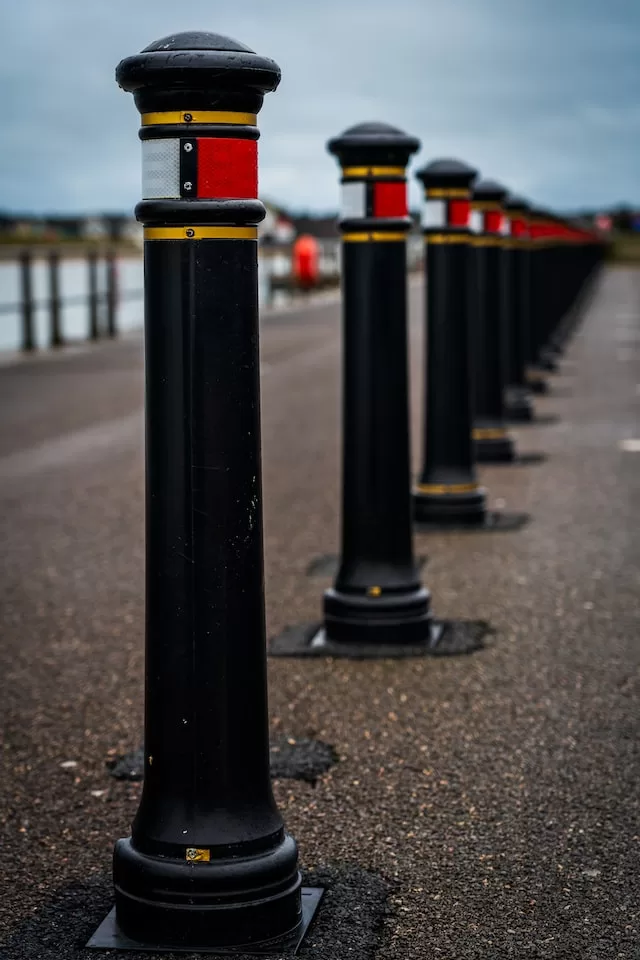Stanchions are generally taller and thinner, while bollards are shorter and thicker. Bollards are also typically made of concrete or metal, while stanchions can be made of either material. Bollards are typically used to control traffic or protect against vehicles, while stanchions are mostly used for crowd control.
Stanchions are typically seen in places like banks and museums, where they are used to create a queue or direct foot traffic. Bollards, on the other hand, are more commonly used as a physical barrier to prevent vehicles from entering a certain area.
What is a stanchion?
A stanchion is a vertical support or post, typically one of a series, for a rail, fence, or barrier. They are commonly used to line up people waiting in queues, such as at a bank or theatre.
What is a bollard?
A bollard is a short, vertical post that is used to create a barrier or delineate a space. Bollards are often made of steel or concrete and can be found in a variety of settings, including sidewalks, parking lots, and driveways.
Stanchions Vs. Bollards – The difference
Bollards are similar to stanchions but are shorter and thicker, and are typically used to protect buildings and pedestrians from vehicular traffic. Unlike stanchions, which are typically taller and have a horizontal component at the top, bollards are shorter and do not have a horizontal component.
When to use stanchions and bollards?
If you need to temporarily or permanently block off an area, stanchions and bollards are two options to consider. Both are devices that can be used to create a barrier, but they have different applications. Here’s a look at when to use stanchions and bollards:
Stanchions:
-To direct foot traffic in a certain direction
-To create a line for people to wait in
-As a crowd control measure
Bollards:
-To block off vehicular access to an area
-To protect buildings or pedestrian areas from vehicle collisions
-As a security measure
How to choose the right stanchion or bollard?
First, consider the environment in which the stanchion or bollard will be placed. Will it be outdoors exposed to the elements? If so, you’ll want to choose a material that can withstand the elements without rusting or corroding.
Second, think about the function of the stanchion or bollard. Are you using it to secure a perimeter? If so, you’ll want to choose a heavier-duty option. Or, are you using it as more of a decorative element? If so, you can choose a lighter-weight option.
Finally, take into account any budget restrictions you may have. With all of these factors in mind, you should be able to narrow down your choices and find the perfect stanchion or bollard for your needs!
Origins of the word “stanchion”
The word “stanchion” comes from the Middle English word “staunchen,” which means “to stop or check.” The word ultimately derives from the Latin word “stantia,” which means “a standing place.”
What is a scaffold stanchion?
A scaffold stanchion is a support structure that is used to provide stability to a scaffold. The stanchions are placed at the corners of the scaffold and extend from the ground to the top of the scaffold. There must be four stanchions in total, and they must be evenly spaced apart.
What is a front-fork stanchion?
A stanchion is a vertical support, typically metal, that is used to provide stability or to mark the boundaries of an area.
What is the correct distance between stanchions?
There is no definitive answer to this question as the correct distance between stanchions will vary depending on the specific application and desired outcome. Generally speaking, however, the stanchions should be placed close enough together to effectively block or guide traffic while still allowing people and vehicles to pass through easily. In some cases, it may be necessary to place the stanchions closer together than usual to create a tighter space that slows down or completely stops traffic.
Photo by Nick Fewings on Unsplash








